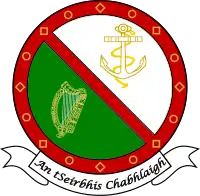| History | |
|---|---|
| Republic of Ireland | |
| Name | Isolde |
| Namesake | Iseult (Isolde) |
| Builder | Liffey Dockyard, Dublin |
| Launched | 1953 |
| History | |
| Name | Setanta |
| Namesake | Sétanta (Cú Chulainn) |
| Acquired | 1976 |
| Decommissioned | 1984 |
| Identification | A15 |
| Fate | Sold for scrapping |
| General characteristics | |
| Type | lighthouse tender, then auxiliary ship |
| Displacement | 1,173 tons |
| Length | 63.4 m (208 ft) overall |
| Beam | 11.6 m (38 ft) |
| Depth | 4 m (13 ft) |
| Installed power | 1,500 hp |
| Propulsion | reciprocating steam engine |
| Speed | 11.4 kn (21.1 km/h) maximum |
| Complement | 44 |
| Armament | 2 × Oerlikon 20 mm cannon |
LÉ Setanta (A15) was an auxiliary ship and training ship in the Irish Naval Service.[1] She was named after Sétanta (Cú Chulainn), a mythical hero of the Ulster Cycle.
Liffey Dockyard in Dublin built her in 1953 as a lighthouse tender for the Commissioners of Irish Lights. She was launched as Isolde,[2] named after the mythical Irish princess Iseult.
In 1976 the INS bought her, had her armed with two Oerlikon 20 mm cannon and renamed her Setanta.[2] She served until 1984 when the INS sold her to Haulbowline Industries Ltd of Cork for scrap.[3]
References
- ↑ "History of the Naval Service". Irish Defence Forces. Retrieved 2 August 2019.
- 1 2 McIvor 1994, p. 145.
- ↑ McIvor 1994, pp. 161, 189.
Bibliography
- McIvor, Aidan (1994). A History of the Irish Naval Service. Dublin: Irish Academic Press. ISBN 0-7165-2523-2.
This article is issued from Wikipedia. The text is licensed under Creative Commons - Attribution - Sharealike. Additional terms may apply for the media files.
